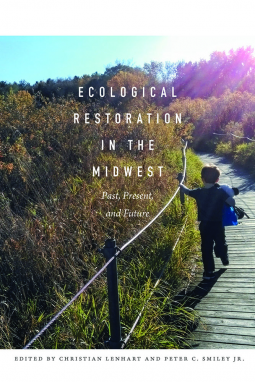
Ecological Restoration in the Midwest
Past, Present, and Future
by Peter C. Smiley, Jr. and Christian Lenhart
This title was previously available on NetGalley and is now archived.
Send NetGalley books directly to your Kindle or Kindle app
1
To read on a Kindle or Kindle app, please add kindle@netgalley.com as an approved email address to receive files in your Amazon account. Click here for step-by-step instructions.
2
Also find your Kindle email address within your Amazon account, and enter it here.
Pub Date Jun 01 2018 | Archive Date Jul 01 2018
University of Iowa Press | University Of Iowa Press
Talking about this book? Use #EcologicalRestorationInTheMidwest #NetGalley. More hashtag tips!
Description
Most people do not realize it, but the Midwest has been at the forefront of ecological restoration longer than perhaps any other region in the United States, dating back to the 1930s. Because of its industrial history, agricultural productivity, and natural features such as the Great Lakes, the Midwest has always faced a unique set of ecological challenges.
Focusing on six cutting-edge case studies that highlight thirty restoration efforts and research sites throughout the region— Iowa, Indiana, Illinois, Wisconsin, Michigan, Minnesota, and Ohio— editors Christian Lenhart and Peter “Rocky” Smiley Jr. bring together a group of scholars and practitioners to show how midwestern restoration efforts have developed, as well as where they are headed. Whether cleaning up contamination from auto plants in Ohio, or restoring native prairie grasses along the Iowa highway, the contributors uncover a vast network of interested citizens and volunteer groups committed to preserving the region’s environment.
This study, intended for researchers, students, and practitioners, also provides an updated synthesis of restoration theory and practice, and pinpoints emerging issues of importance in the Midwest, such as climate change and the increase in invasive species it will bring to the region. Though focusing exclusively on the Midwest, the contributors demonstrate how these case studies apply to restoration efforts across the globe.
Contributors: Luther Aadland, David P. Benson, Andrew F. Casper, Hua Chen, Joe DiMisa, Steve Glass, Heath M. Hagy, John A. Harrington, Neil Haugerud, Constance Hausman, Michael J. Lemke, Christian Lenhart, Jen Lyndall, Dan Shaw, John A. Shuey, Peter C. Smiley Jr., Daryl SmithAdvance Praise
“The editors and authors bring together the history, theory, and practice of ecological restoration in the Midwest into a much-needed resource. There is no comparable book dedicated to the broad range of topics, challenges, and successes of restoration for this region of the United States.”—Christopher A. May, the Nature Conservancy
“The Midwest is really the birthplace of restoration ecology. Until now there has been no comprehensive text that covers the history and multitude of restoration projects done in the Midwest. This volume by Lenhart and Smiley remedies this situation. A must-read for restoration ecologists in the Midwest and beyond.”—Douglas D. Kane, Defiance College
Available Editions
| EDITION | Paperback |
| ISBN | 9781609385736 |
| PRICE | $45.00 (USD) |
| PAGES | 296 |
Average rating from 4 members
Featured Reviews
 catherine h, Reviewer
catherine h, Reviewer
I'm a bit of a skeptic when it comes to ecology these days. I live in the Cleveland area and have watched this restoration for a very, very long time. I'm probably not it's target audience either, but find it of note. I guess my skepticism stems from my time in a botany class in college (it's been a while, but I don't think some things change that much.). Our factories have mostly folded and I have been watching the transformation of land along the Cuyahoga River. My question is- How do the heavy metals get out of the soil? Plant what you will, the soil is still contaminated with God only knows what. Think it leeches out somehow or magically disappears? It's not all washing out into the water table. New farms along the river and community gardens worry me. I pray those foods aren't making their way into my diet. Detroit, Michigan becoming known for farms??? Too scary to think about. I hear Lake Erie is making a comeback and getting "healthier due to the great number of midges, mayflies and other critters. Yet mercury remains in the lake bottom.We "rescued" land from farmers in what became the Cuyahoga Valley National Park, THEN turn around and leased the farms to urban farmers to farm! Then there's the MetroParks, hardly the wild life area and nature reserve it was when I was growing up, it now resembles a city park. Sad. The nature trails, intrepretive centers with their asphalt aren't good. It's funny how environmentalists will rant about asphalt parking lots at stores, yet heartily applaud the new whatever with IT"S not ecologically sound parking lot. I guess it's all about who's running the show. I'm not convinced I believe the hype.
But the book is an interesting read as I got to read about what other places are blowing their horns about. I just wonder if all this isn't just a distraction from what's really going on (fracking comes to mind...) Ah, well, business as usual.
Anyone who wants to read about what may or may not be actually happening will likely find this book interesting. It's been well-researched.
Readers who liked this book also liked:
Silvia Moreno-Garcia
Historical Fiction, Literary Fiction, Sci Fi & Fantasy








